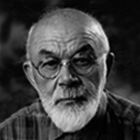Balogh István
1924 - 2016

Balogh, István
An important poster artist after 1955, István Balogh was primarily active in the field of movie posters. Balogh had a sense for fine and delicate drawing and a marked disposition towards the grotesque and caricature.
Between 1947 and 1948, Balogh was student at the University of Applied Arts, then at the University of Fine Arts, where he studied under István Köpeczi-Bócz and György Kádár. Beginning his career in the 1950's, he started to design posters, working mostly for MOKÉP (Hungarian Film Distribution Company) on movie posters.
Balogh also had a great career as teacher and professor. Working at the high school for arts and next at the Universityof Applied Arts, he had a significant impact on the next generations of designers.
Between 1963 and 1983, he was member of the Papp-group, and took part in their exhibitions. He often worked on the graphic design of exhibitions and fairs, such as Hungexpo. He also illustrated magazines that focused on export, such as the Hungarian Foreign Trade and Hungarian Travel Magazine. Today he is a member of the Hungarian Poster Association.
At the end of the 1950s, his works were defined by strong contrasts, intense colour fields, and the rhythm of the forms. The 1960's marked the beginning of a flourishing period for movie posters in Hungary, and Balogh played an important role in this process. His artistic attitude complimented two new cinematic movements: Italian neorealism and French New Wave. Balogh’s posters are often grotesque, satirical, and funny. He likes to create delicate drawings as well as compositions of paper cut and photomontage.
Balogh has also worked for official occasions, such as commemorations and festivals (1st of May, 4th of April etc.). Most of these works are painted, and they use well known state symbols in an imaginative way. He also prefers to create own symbols, such as the peacock and other birds, which are symbols for freedom. These motives often appear in the manner of Hungarian folk art, but combined with the modern tendencies of the sixties. The poster for the Bartók choir festival gives a splendid example to his delicate sense of style. In addition to the governmental campaigns, Balogh worked for the tourism industry as well. One of his outstanding works is his poster of Lake Balaton, which reflects the harmony and beauty of Matisse’s paintings and the beauty of the landscape by Balaton. .


































